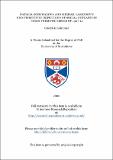Files in this item
Natalia Goncharova and Mikhail Larionov's neo-primitivist depictions of social outcasts in their thematic series of 1907-14
Item metadata
| dc.contributor.advisor | Lodder, Christina | |
| dc.contributor.author | Kramer, Cheryl Ann | |
| dc.coverage.spatial | xxi, 293, [105] p. | en_US |
| dc.date.accessioned | 2018-11-19T10:51:41Z | |
| dc.date.available | 2018-11-19T10:51:41Z | |
| dc.date.issued | 2000-06-22 | |
| dc.identifier.uri | https://hdl.handle.net/10023/16496 | |
| dc.description.abstract | This study addresses the contemporary political and social issues raised by the subject matter of Natalia Sergeevna Goncharova (1881-1962) and Mikhail Fedorovich Larionov's (1881-1964) Neo-primitivist series of 1907-14. The ideological implications of the themes are explored, and it is argued that their development of anti-heroes challenged the mores celebrated by the status quo within Tsarist Russia. Chapter I investigates the prevailing ideological climate and provides a cultural and political contextual framework for the development of Neo-primitivism and the choice of subject matter. The subsequent chapters focus upon specific thematic cycles. Chapter II argues that Larionov and Goncharova's paintings on low-life and hooligan subject matter are anti-social works that undermine the affectations of the civilized behaviour advanced by polite, urban society. Chapter III examines Larionov's prostitute paintings and argues that the artist's unorthodox treatment of the nude challenged the viewer's conception of the classical nude, prostitution and sexuality, as well as the role of women within the Russian patriarchy. Chapter IV argues that the cycle of paintings Goncharova devoted to labouring peasants highlights the traditional way of rural life as a call for the regeneration of contemporary society. Chapter V explores Larionov's soldier series and argues that the artist debased traditionally revered sources to produce coarse paintings that mock the soldier as a symbol of patriotism, thereby satirizing the Tsarist regime. Chapter VI argues that Goncharova's body of work on Jewish themes incorporate both anti-establishment and anti-assimilation statements. This choice of themes countered established values, and this was enhanced by their Neo-primitivist style. The artists confronted the viewer with images grounded upon various contradictions that call the seemingly disparate subject matter, the means of representation and the symbolism into question. The anti-establishment ethos that underpins these works is central to the understanding of Goncharova and Larionov's series of 1907-14. | en_US |
| dc.description.sponsorship | "Research in Russia would not have been possible without three awards from the University of St. Andrews: the first from the Russell Trust, issued by the Post-Graduate Office; the second and third from the Gapper Trust, issued by the School of Art History. " -- Acknowledgements | en |
| dc.language.iso | en | en_US |
| dc.publisher | University of St Andrews | |
| dc.subject.lcc | ND688.K8 | |
| dc.subject.lcsh | Goncharova, Nataliia Sergeevna, 1881-1962 | |
| dc.subject.lcsh | Larionov, Mikhail Fedorovich, 1881-1964 | |
| dc.title | Natalia Goncharova and Mikhail Larionov's neo-primitivist depictions of social outcasts in their thematic series of 1907-14 | en_US |
| dc.type | Thesis | en_US |
| dc.contributor.sponsor | Russell Trust | en_US |
| dc.contributor.sponsor | Gapper Charitable Trust | en_US |
| dc.type.qualificationlevel | Doctoral | en_US |
| dc.type.qualificationname | PhD Doctor of Philosophy | en_US |
| dc.publisher.institution | The University of St Andrews | en_US |
This item appears in the following Collection(s)
Items in the St Andrews Research Repository are protected by copyright, with all rights reserved, unless otherwise indicated.

